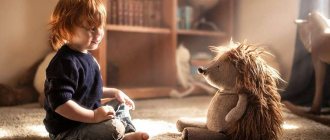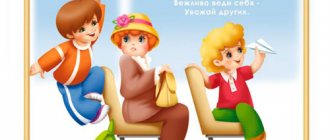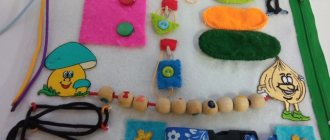“Professionals work in the kindergarten; they will teach him everything. We pay money, after all!” - this is how many parents argue, and then they are surprised that all the mothers and fathers of the group are up in arms against their child. The baby is uncontrollable, he bites and is rude, takes away toys and food, and the question arises about his mental state. But the reason may be less terrible and more banal: the child simply was not taught how to behave in a group. You can and should rely on educators, but you shouldn’t make a mistake yourself. It is important to instill good manners in your child from the first years of life and learn etiquette together. Then you won’t have to blush in front of kindergarten workers or other parents. To teach your child quickly, refer to this simple list of rules that apply in all kindergartens in Russia.
Communication with adults
Rules of behavior for children in kindergarten begin with the norms of proper communication. The child is afraid of new adults and is embarrassed, so it’s worth explaining to him how to behave with his uncles and aunts so that everything is fine:
- All employees must be called by their first name or patronymic or addressed as “You”. Make sure that your child learns the teacher’s first and last name. Addressing the form disciplines him. To do this, do not deviate from the rules and repeat the full name yourself, and not an abbreviation or nickname.
- When meeting, you need to say hello and, if necessary, ask permission. If you need to go out, find out something, complain about something, it is important to first clarify whether this can be done. Before you leave, you need to ask permission and say goodbye. These basic rules will help maintain the child’s safety and raise his social rating in the eyes of educators.
- You cannot interrupt an adult or raise your voice at him. The child must learn discipline, otherwise there will definitely be problems at school.
- If a child is hit, bitten, offended, or witnesses the escape (kidnapping, fainting, seizure) of another child, he must immediately complain to the teacher, but calmly and quietly state all the facts, without shouting or insulting the offenders.
- You cannot touch adults, much less beat them. It is important to maintain a boundary between yourself and the teacher.
It is important to learn that the teacher must be obeyed, because the child cannot yet be responsible for himself and his actions. He must follow orders and not react aggressively to criticism. If the child feels that the teacher treated him unfairly, he should tell his parents about the situation, they will sort it out. But you can’t take revenge yourself and become hysterical. You must remain calm in public places.
How and why can children make a teacher’s life unbearable?
To begin with, I will quote the reader: “...I came to work in a preparatory group, where children are from 5-7 years old. At first I seemed to cope and the kids obeyed, but now I just can’t get along with some of them (thank God, there aren’t many of them). I don’t understand where I missed them. Another problem is that these some leading children drag the entire group along with them. The result: everyone is “standing on their ears” and it is very difficult to collect them later.
Please advise how to behave, or maybe what methods there are, I ask for advice as an experienced teacher. Unfortunately, I have no experience, I’m just learning. I came to the garden, and I didn’t want to run away from there, I love the kids, they’re all great guys, but here’s their behavior...”
The situation is clear; many of us have gone through this. Apparently, as far as I can tell, my colleague initially did not want to be strict and set limits on what was permitted in the group for the students. And children need frameworks and rules for full development. The sooner restrictions are set, the easier it will be for educators, parents and the children themselves in the future.
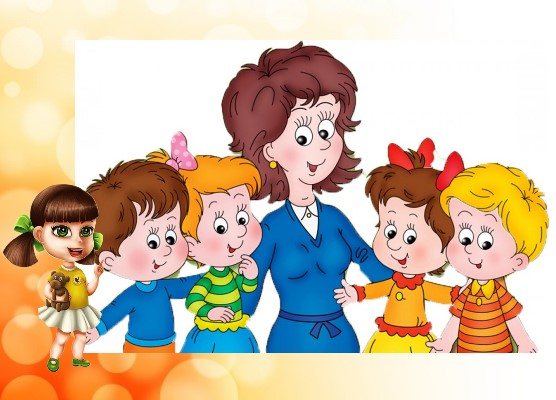
My colleague understands that she made a mistake, but does not know where. It is difficult for me to judge in this situation what exactly provoked the loss of authority of the teacher, but we will try to correct the matter. You, colleague, will do this not only for yourself, but also for your students who are preparing for school, where the issue of discipline is very tough.
Having become accustomed to not listening to the words of the teacher, within the walls of the educational institution they will earn the stigma of uncontrollable and unwanted students.
Psychologists identify several reasons for poor discipline among preschoolers:
- Need for attention;
- Leaders' struggle;
- Protection from failures, disapproval;
- Revenge for wrongs caused;
- Banal boredom.
If there is one child in the group with the charisma of a leader, it is easier to establish discipline, but if the teacher has several such “competitors”, complex therapy will have to be carried out in a team. Get ready for the fact that you will have to systematically and persistently implement new rules and change the way of life in the group.
Communication with children

This is the most important point of the rules of conduct for children in kindergarten. If your baby does not behave as expected, you may have serious problems. Many parents react very violently to the slightest offense inflicted on their child. They can seriously spoil not only your mood. So teach your child caution, tolerance and common sense when interacting with children:
- You cannot beat, insult, or touch other children, even if they allow themselves to do so. In response to beatings and curses, you need to complain to your parents and teachers, and no longer communicate with the aggressor. It is better not to approach cruel children at all.
- You cannot boast about your financial situation and humiliate other children with hints about their poverty. The child himself has not yet earned anything, and in this sense all children are equal.
- You can’t spoil other people’s things and allow them to break your own. If other children break a toy, it is important to complain to parents and teachers in order to avoid a conflict.
- You cannot take other people's things for yourself, either secretly or openly. If you really want a toy, you need to ask your mother for it, and not take it from others. You cannot even accept a toy as a gift, as this may cause indignation among parents who bought this item for their child and do not intend to lose it.
- You cannot interrupt, shut up, or discuss other children behind their backs. A polite person will always listen to others and will not impose his opinion if they do not want to listen to him. It is also important not to occupy the airwaves with your person. Many children talk a lot and do not allow a word to get in, and therefore very soon they are left without listeners and worry, not understanding why this happened.
Any conflict situations are resolved by the teacher; he is an arbiter and judge.
Don’t be shy about complaining, because timely intervention will prevent a fight. If a child does something that is forbidden, imitating bad examples, this should also be reported to the teacher. Only he can call the parents and notify them about the problem that has arisen.
Parents themselves must set a good example. There is no need to sort things out with children who have done wrong. This is not your job, you have no right to scold and shame them. You can express your indignation in a calm manner to the teacher and parent if the problem is serious. But there is no need to throw a tantrum, especially in front of children. Fights and other antics will only worsen the situation and force you to look for another kindergarten. But you are neighbors, why should you quarrel?
Methods for establishing discipline
To begin with, you should work on yourself, building a line of behavior in order to establish authority. The style of communication with children presupposes strictness in matters of principle, affection in all situations and kindness, humor, but without sarcasm, tact, but frankness, and responsiveness. The main thing is a sincere interest in the personality of each child. There are no bad children, there are unfortunate ones...
The ultimate goal of the teacher is to arouse interest in himself, a desire to communicate on the part of children, obey orders with pleasure, readiness to fulfill a request, earn approval, a gentle look, a word, a gesture. Your stern look and word when discipline is violated should not cause anger, resentment, dissatisfaction, but shame for your actions and the desire to immediately correct the situation.
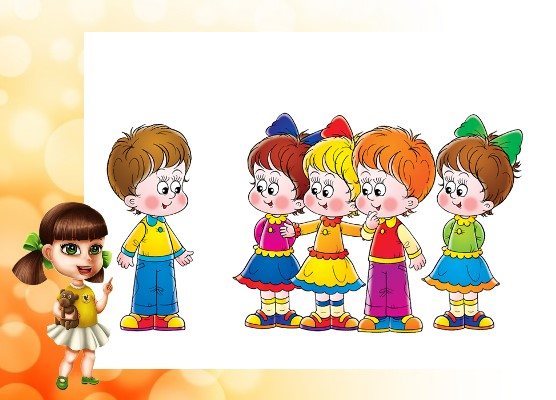
In your situation, colleague, leaders need to be organized and led. Such guys are really looking forward to recognition of their leadership qualities, so delegate authority to leaders and entrust them with discipline duty. I think it’s worth having a conversation with the group on the topic of what is bad and good, together define and write the rules by setting up a special stand, where there are also photos of children and daily marks on behavior in the form of stars of three colors.
Red – bad, yellow – normal, green – excellent. Every day, do not forget to give ratings together with the children, let them determine which star they deserve. Don't forget about incentives and advances. If a child is too deeply offended by well-deserved red stars, reward him with yellow or even green, but explain your decision to all children. Don't allow injustice!
And to attract attention and eradicate outbreaks of disobedience during classes, there is the following technique: bell, tambourine, whistle, pipe. Announce that you will check who is the most attentive and, at the signal of a whistle or tambourine, will fall silent and look at the teacher. Train constantly until the reflex is developed.
You can complicate the task: as soon as the signal sounds, everyone stops and repeats the movements of finger gymnastics or just exercises after the teacher. The bell rings: everyone watches and repeats who is great and deserves praise or a star. And so on every day until you reach automaticity. Warn children that you will signal unexpectedly.
Table etiquette

During meals, the upbringing of a child is most evident. Cultured children eat carefully, do not criticize food, do not spit, or disturb others. Therefore, it is very important to leave all table games at home. Yes, and there they are inappropriate, to be honest.
- You should not talk with your mouth full, play with food or bite too large pieces (this is very dangerous). You could choke or stain your neighbor, furniture, and yourself.
- You cannot put your elbows on the table, swing on a chair, or swing your arms and legs during a meal. All games are after meals.
- Drinks should be drunk in small sips, main courses should be eaten with a fork, and soup with a spoon. This is obvious to you, but often the child makes mistakes even in such trifles.
- After eating, wipe your lips and hands with a napkin. After eating, you need to go to the toilet and rinse your mouth so that all food particles are removed.
- You can't talk bad about food and offend chefs. After eating, you need to thank and put away the dishes.
If a child doesn’t like the food, he should tell his parent about it after class, and not shout at the whole Ivanovskaya.
If he cannot eat at all, you need to tell the teacher that he cannot eat, otherwise he will feel bad. In such cases, the employee will not force him to eat food. In some children's institutions, children set the table themselves. In this case, you need to explain to the child that he cannot run, dance, or be distracted when he is carrying a plate. Otherwise, injury cannot be avoided, and all the contents will fall out onto the floor.
Other techniques to stop negative manifestations
In case of isolated manifestations of violations of discipline during important security moments, the following measures can be taken against the “troublemaker,” especially if the child’s actions are, to put it mildly, inadequate:
- Ignoring or minimal attention to the offender;
- Focused gaze into the child's eyes without anger or condemnation, calmly but intently, as if we were stopping with our gaze;
- Addressing the child in a specially intoned voice: in some special tone we say something like “Look at me, please,” in a lowered, changed voice;
- We abruptly stop any activity and say: “We’ll wait until Petya can join us”;
- A non-standard question or gesture (affectionate) that will distract the child;
- Voicing his state: “You hate me, you are very angry with Petya, you are tired and angry”;
- Praise often stops you: “You kick your legs so beautifully, how do you do it?”, but without mockery, in a friendly way, without laughter;
- You can sit on a chair to think, but not in a corner.
In principle, these methods and techniques should be enough; at the end of the article I would like to share some tips on good teaching aids:
- “Planning the organized educational activities of a teacher with children of the preparatory group: technological maps for every day according to the program “From birth to school”, ed. N. E. Veraksy, T. S. Komarova, M. A. Vasilyeva. December-February";
- “Organization of children’s activities during a walk. Preparatory group";
- “How to help an autistic child. A book for parents. Toolkit";
- “Special offer to top up your personal account + participation in the offline webinar “How to organize the work activity of a preschooler?”
I really hope that my young colleague will take advantage of the ideas I proposed and be able to cope with negative manifestations in the children's team. If you find my article interesting, share it with your friends, and if you want to constantly read the materials, subscribe to the news.
Sincerely, Tatyana Sukhikh! Till tomorrow!
By the way, I recommend reading:

Etiquette in the toilet and bedroom
The most sensitive topics tend to raise the most questions and misunderstandings from kids. This is rarely discussed with them, and they have nowhere to get information from. Therefore, discuss with your child the rules of behavior in kindergarten that govern his trips to the toilet.
- Crowding around sinks and toilets is prohibited. If more than 6 children have already entered the room, you need to wait. If it’s completely unbearable to stand, you need to ask the teacher what to do? It will help you find a way out faster.
- You should always use toilet paper and flush after yourself. If there are any drops left on the seat, they should be wiped off and your hands should be washed immediately afterwards.
- After visiting the toilet, you should wash your hands with soap and dry them. This is a must, otherwise it’s easy to get sick.
- It is prohibited to splash water, climb onto radiators, or throw various objects into the toilet. You cannot draw on the walls or floor, even if you really want to.
- You cannot lock yourself in the toilet to play or deceive the teacher.
It is also important to remind your baby how to go to bed correctly. This ritual has its own recommendations.
- Before quiet time, children brush their teeth and go to the toilet for their needs.
- You cannot be capricious and argue with the teacher about the fact that you don’t want to sleep or are too lazy to brush your teeth. You need to listen to nannies and children's teachers.
- You cannot play or throw pillows in the bedroom. These activities disturb everyone and disrupt their routine.
- If you need to leave, it is important to do it slowly, carefully, calmly, so as not to wake up other children.
- Clothes must be folded in perfect order on the chair.
A daily sleep schedule is very important for children, because if it is not there, their evening activity will drive the parent crazy. Sleeping during the day calms the child and normalizes the state of his nervous system. So you need to teach your baby not to interfere with others, if he really does not want to end up in bed. We would like his problems!
Behavior of children in kindergarten: senior preschool age
The behavior of a 5-year-old child differs from the actions of a 3-4 year old child. At this age, the child is not just part of the team, but is looking for his own niche in it. If before this the preschooler unquestioningly followed the chosen leader, now he is quite capable of having his own idea of who exactly to be in the team: leader, leader or follower. Based on this, the child acts in one way or another, and the team does not always accept his position unconditionally. It happens that a child sees himself as a leader, but the team assigns him a completely different role, for example, a follower. In this case, the child’s self-esteem may not coincide with the assessment of his peers and it is very difficult for him.
At the age of 6-7 years, children, as a rule, experience a greater need for contact with peers. This distinguishes them from the behavior of a child at 5 years old. The preschooler singles out a few kids from the entire group with whom he communicates most often. At this age, the first “real” friends appear, and the entire kindergarten team is divided into small groups based on interests.
The task of educators is to establish relationships between children, to attract their attention to the personal qualities of their group mates, to interest and encourage them, that is, to do everything possible to ensure that the child’s behavior in the preschool educational institution is friendly and consistent with accepted norms, and does not go beyond established boundaries.
Behavior on site

Going outside for preschoolers is fraught with many dangers. Outside the kindergarten, a child can get seriously injured or even get lost if he does not know the rules of behavior in kindergarten and during walks. Teach the tomboy to obey his elders and follow all the recommendations of common sense, which the little one has not yet developed.
- You need to go out onto the playground or into the street in pairs and formations, as the teacher said. On the way back, you need to make sure that your date is in place and that everything is okay with her.
- You cannot leave the playground without the accompaniment or consent of a teacher. Any attempts by strangers to talk to adults, give something, or take them outside the fence must be stopped. You need to immediately run to the teacher and tell him everything. Under no circumstances should you take candy and toys, talk, or leave with strangers.
- It is forbidden to run in front of swings and carousels, they can injure the child.
- Before starting a group game, you need to listen to the rules of conduct and follow them.
- You can’t run or jump too actively, otherwise you might hurt others.
Parents must also follow the rules of the game: do not pick up the child until you have agreed with the teacher.
And if you are delayed or have changed the choice of escort to your home, please inform us in advance. Even if a conflict situation arises in kindergarten, do not lose your temper in front of the children and do not force your son or daughter to blush for you. It is important to explain everything calmly. And, of course, only for adults. Do not contact other children, and certainly do not scold them.
Cultured people always come from cultured families. Whatever the kindergarten, it is the parents who are the main authorities for the child, they are the ones who bear the main responsibility for his upbringing. Don't set a bad example, and your baby will learn only good things.
How to get on and off public transport
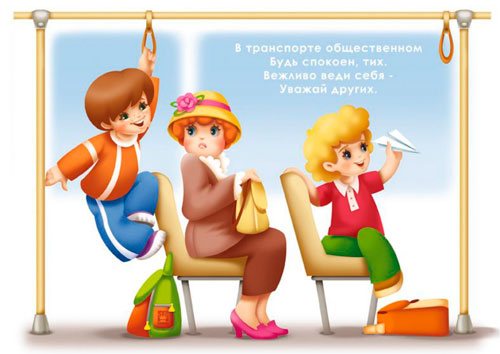
There are special rules in this regard that children need to know.
- You must wait for a bus, trolleybus or other means of transporting passengers in special places - at stops. Trying to stop it in some other places is wrong. This can create an emergency situation and, as a result, put the life of the child and other people at risk.
- You should only get on a bus or tram when it has completely stopped. Jumping into open doors while walking is prohibited.
- If the vehicle is full, it is better to wait for the next one.
- Before entering a bus, tram, etc., you must wait until other passengers get off.
- You should board the bus slowly, without jostling or trying to get ahead of other passengers.
- Once on the bus, you should not stop at the door (unless you need to get off at the next stop). It is necessary to go deeper into the cabin to make room for exiting passengers.
- There is no need to push and break through to the exit of the vehicle first. You need to go out decorously and calmly, observing the order.
- After getting off the bus (tram, trolleybus), you need to wait until it leaves and only then cross the street.
- You should always remember and follow the golden rule, which states that the tram should be walked around in front, and the trolleybus and bus - behind.
Scheme for monitoring child behavior
SCHEME FOR MONITORING A CHILD'S BEHAVIOR
Child's full name
Date of completion Filled out by: parent, psychologist, teacher
| Nature of the violation | What exactly was this behavior disorder manifested in? | |||||
| Aggressiveness | physical | Breaks toys, tears up books, pushes peers, hits adults as he passes, bites, spits | ||||
| Hidden | Pinches others, says hurtful words when an adult doesn’t hear | |||||
| Verbal | Swears, says offensive words, says obscene words | |||||
| As a threat | Swings but doesn't hit, scares others | |||||
| In facial expressions | Purses his lips, turns red, turns pale, clenches his fists | |||||
| As a reaction to the restriction | Resists when trying to deter aggressive actions, the obstacle stimulates aggressive action | |||||
| Self-directed | Bites himself, pinches himself, asks himself to hit again | |||||
| hot temper | In physical actions | Unexpectedly for everyone, he throws toys, can tear up the manual, spit | ||||
| In speech | May unexpectedly respond rudely or say an obscene word | |||||
| negativism | In physical actions | Does everything the opposite, has difficulty joining a group game | ||||
| And failures | Refuses even interesting activities | |||||
| verbal | He often says the words “I don’t want or I won’t”, no | |||||
| demonstrativeness | In movements | Turns his back, exaggerates movements during class | ||||
| How to focus on your own state and behavior | Strives to draw attention to himself at the expense of organizing classes; doing something the opposite, observing the reactions of others | |||||
| Touchiness (emotional instability) | How to react to an obstacle | Gets offended when losing a game | ||||
| In facial expressions | Displeased facial expression, crying | |||||
| Reaction to evaluation of others | Reacts painfully to comments, painfully reacts to a raised tone of voice. | |||||
| conflict | Active or reactive | He himself provokes conflict, responds conflictingly to the conflicting actions of others | ||||
| Due to egocentrism | Does not take into account the desires and interests of peers | |||||
| Like lack of experience | Joint activities, relationships | |||||
| Due to difficulty switching | Not inferior to toys | |||||
| Emotional withdrawal | Like centrifugal tendencies | When all the children are together, they seek privacy | ||||
| And emotional absorption in the activity | Enters the room and immediately goes to the toys: busy with his own business and does not notice those around him | |||||
| And features of speech behavior | Does not use speech as a means of communication; when he speaks, the speech is not addressed to the interlocutor | |||||
| Like pseudo-deafness | Does not fulfill the request, although he hears and understands the content of the requirements, does not respond to the transition from normal speech to whispered speech | |||||
| And features of eye contact | Avoids looking the interlocutor in the face. | |||||
| Goofiness | Reaction to a remark | Reacts with laughter to an adult's remark; praise or blame does not cause a significant change in behavior | ||||
| In physical actions and facial expressions | Fooling around, imitating movements | |||||
| indecisiveness | In social relationships with others | Avoids the situation of oral questioning in class, does not answer, although he knows the answer, refuses leading roles in games. | ||||
| Manifests in speech | Uses words: “I don’t know”, “maybe”, “it’s hard to say”, the child does not answer the question, although he knows the answer | |||||
| In physical actions | Afraid to jump from a hill | |||||
| Reaction to novelty | In a situation of novelty, the child exhibits inhibitory reactions; in a new situation, behavior is less variable than in a familiar situation. | |||||
| Starhi | Specific | Fear of a vacuum cleaner, a dog, the dark, gusts of wind | ||||
| Reaction to novelty | Afraid to enter a new room | |||||
| Social | Fear of new people in a new situation, fear of public speaking, fear of being alone | |||||
| anxiety | In facial expressions | Wandering, distant gaze | ||||
| In speech | In speech | |||||
| In movements | In movements | |||||
| In relationships with others | Sleeps with parents, strives to be closer to adults | |||||
| stiffness | In movements | Motor restricted | ||||
| In speech | Stutters in speech | |||||
| Reaction to novelty | Reaction to novelty | |||||
| lethargy | In cognitive activity | Doesn't know what to do | ||||
| In visual perception | Idlely looking around | |||||
| In speech | Speaks too quietly | |||||
| Reaction time | The pace of actions is slow, when performing actions on a signal there is a delay | |||||
| Self-centeredness | How to treat yourself | Believes that all the toys, all the candies are for him | ||||
| In relationships | Believes that all the toys, all the candies are for him | |||||
| In speech | Often uses the pronoun "I" | |||||
| Avoidance of mental effort | In conditions of free activity | Doesn't watch cartoons | ||||
| In organized classes | Quickly gets tired of age-appropriate mental tasks (comparing, generalizing, following a pattern) | |||||
| Attention deficit | Concentration | Looking around during class | ||||
| In the content and assistance to the child | You have to repeat the task verbally several times; you need to combine the word with a demonstration of the method of action | |||||
| In speech | Conditions for completing the task, etc. | |||||
| Motor disinhibition | Features of action planning | Hastily plans his own actions | ||||
| Excessive pace and number of actions | The pace of actions is accelerated, the number of actions is excessive (many unnecessary movements), it acts before the signal | |||||
| Duration of control of hyperactivity | Gets up during the first half of class when other children are still sitting | |||||
| Duration of mastery of the state | Quickly aroused and slow to calm down | |||||
| Speech disinhibition | Speech volume | Speaks too loudly, cannot speak with normal voice strength | ||||
| Speech rate | The pace of speech is accelerated, speech is excited | |||||
| In social relationships | Talks over words in class despite an adult’s comments | |||||
| Failure to understand complex verbal instructions | Confused or misses the sequence of actions following verbal instructions | |||||
| Failure to understand complex verbal instructions | Focuses on a clear example of an adult’s behavior or actions, rather than on an explanation of the task | |||||
| Getting stuck | In movements | Draws repeating elements | ||||
| In relationships | Intrusive when communicating, attracts attention to himself, repeats the same request | |||||
| In speech | Repeats the same phrase over and over again | |||||
| On feelings and emotions | Gets stuck on resentment | |||||
| Switching difficulties | Difficulty shifting, etc. | |||||
| Performance (mental) | Gets tired quickly from a task that requires mental activity, gets tired when reading a book, gets tired during the first part of an organized lesson | |||||
| Performance (physical) | Gets tired quickly while walking, gets tired from physical activity, loses performance in the first third of an organized lesson, loses performance in the first third of an organized lesson, requires varying the complexity of a task that does not require mental effort, performance fluctuates throughout the day, alternating increased and decreased performance | |||||
OBSERVATION PROTOCOL
FULL NAME. observer
FULL NAME. observed
Date _________________ Start time ____________________ End time __________________________
Situation
| Fragment of the situation | Emotional reactions | Verbal reactions | Nonverbal reactions | Behavioral reactions | Comments |
Conclusion
Protocol for monitoring a child during the theatrical activity “Circus”
Name, age:
Vitya, 5 years old (middle group)
Purpose of observation:
will reveal the child’s ability to speak in front of an unfamiliar audience.
| Facial expressions | Actions | Speech |
| Eyes down to the floor | Hands in fists | speaks quietly |
| He sat on a chair and watched the actions of other children. | ||
| Turned away, not following the actions on stage | ||
| Smiling | Keeps an eye on the children | Silent |
| Tugging at the belt on his suit | ||
| Got up | Memorized speech according to plan | |
| Looks down when he speaks | Speaks quickly | |
| Doesn't pay attention to children | ||
| Watches the teacher | ||
| Claps | ||
| All the children sing, but he doesn’t | ||
| Smiling | Dancing | Says something to a neighbor |
| Sings |
Conclusion:
According to the stated goal, I can conclude that the child was a little shy and perhaps felt insecure; this may be evidenced by the fact that the child did not look into the audience and often stood behind all the children or somewhere to the side during the performance.
But despite the possible embarrassment, the child, although not loudly, pronounced his text well, all the words were understandable, Vitya did not stutter.
According to the teacher, Vitya himself took the initiative to participate in the production.
They had never noticed anything like this about the boy before. Monitoring young children
In general, recommendations for monitoring a preschool child can be formulated as follows:
Ø Before you begin direct observation of the child, it is necessary to establish contact with the teachers and the assistant teacher of the group. During the internship, the psychologist becomes part (albeit independent) of the adult group.
Ø Relationships with adults should be built on a business basis, but at the same time be emotionally warm. It is better to coordinate your actions in advance with the actions of the teacher, thereby preventing misunderstandings and various kinds of misunderstandings, but it is not at all necessary to communicate the true purpose of the study (what will be the subject and who will be the object of observation).
Ø Focusing on mutual understanding in relations with educators, it is necessary to maintain one’s own independence and autonomy. The psychologist’s task does not include identification with educators. Support and understanding of educators and their assistants are needed in order to organically “fit” into the natural setting of the group and thereby minimize the impact of their presence on the observed process.
Ø During observation, the psychologist’s task is to maintain a neutral position, without in any way influencing the events taking place with his actions and words. The intervention of a psychologist is possible only when there is a threat to the health and life of children.
Ø It is possible that on the first day of observation the children will have numerous questions for the psychologist about what he is doing, as well as requests or offers to play with them. You should not give your children lengthy and confusing explanations to such questions; rather, briefly but firmly answer that you are currently working and therefore cannot play. If you promise your child to play with him at another time, indicate the exact place and time of the game (for example, “In the evening on a walk”) and be sure to fulfill your promise, otherwise the next observation may be disrupted by the child you deceived.
Ø As a rule, if the psychologist managed to take the position of a neutral observer in the group the first time, the entire subsequent series of his observations will take place in a good working environment, and the children’s attention to him will be minimal. It is necessary to note one more important point; it can be described as “conservatism of the observer” - conservatism of clothing (it is better to avoid bright clothes and bright makeup during observations), constancy of behavior and manners, as well as constancy of the workplace.
Ø Workplace. It is worth determining the observation location in advance and coordinating your action with the teachers. You need to choose a place where you can clearly see and hear all the events taking place, but at the same time attract a minimum of attention to your person. It is better to fix the workplace with special attributes (table, chair), thereby defining your “working” position.
Ø Regardless of when and where the observation is carried out, the general requirements
remain as follows:
1) the entire observed process is recorded (the use of technical means for recording is possible, but their use imposes a number of special requirements);
2) the observation record must indicate the exact time, observation conditions and participants in the observed process;
3) observing one child and recording all his actions, statements and other manifestations, the observer also records the actions, statements and manifestations of other children and adults with whom the observed child is in interaction. It is important to prevent the one-sidedness of recording factors: it is necessary to record not only the result of the interaction, but also the reasons that caused it;
4) try to be precise in determining the observed facts - do not simplify or complicate what you see (be objective in your recording). Record all children’s statements verbatim, without changes, indicate intonation, pauses, tempo and other features of speech. Reflect emotional manifestations truthfully.
Ø When conducting a series of observations of one child, it is better to organize observations under different conditions:
· during the work of one and the other teacher, possibly in the absence of both (for example, at a music or physical education lesson);
· during various routine moments (during meals, during classes, while walking, in free activities, etc.).
Ø There is no need to rush to draw conclusions based on 1-2 observations. It is necessary to take into account the influence of many factors and try to avoid situational distortions in the child’s perception.
When observing, it is necessary to record and take into account the following aspects in the child’s actions and activities:
1. attitude
child to others (children, adults);
2. manifestations of general motor activity
;
3. manifestations of the affective sphere
;
4. Features of hand movements and reactions
;
5.
features
of speech
;
6.
the presence of
spontaneous statements
;
7.
features
of performing actions
;
8. positions
a child in joint activities with someone;
9. self-esteem
child.
The best way to generalize the results of observations would be to harmonize them with data from other psychodiagnostic studies.
Example of an observation diary
It should be noted that the observation diary below is an example of participant observation. Participant observation is a type of observation in which the researcher has the opportunity to directly interact with the child being studied. This type of observation has its positive and negative sides, the consideration of which is not part of our task. We invite you to independently evaluate the advantages and disadvantages of this type. Considering that both the included and neutral forms of observation are possible for studying young children, we, nevertheless, insist on a neutral one, in which the interaction of the researcher with the observed child is excluded.
DIARY OF OBSERVATION OF A CHILD
The observation was carried out in the nursery group of a city kindergarten. Dasha's age at the beginning of observation was 3 years and 6 months.
February
I learned from the manager that I would need to supervise Dasha. Nadezhda Vasilyevna, immediately after we met, suggested that I monitor this girl and explained her decision to me by saying that Dasha attends kindergarten more often than anyone else and rarely gets sick. I really didn’t like the fact that they made a choice for me, so all the desire to monitor Dasha disappeared. And Dasha and I met in the following way.
After our conversation with the head, I went to the nursery group and just entered the locker room when I suddenly saw in front of me a very beautiful little girl with big brown eyes. Her look made me forget about everything in the world. I remember that at that moment I had only one thought in my head: “Is it really Dasha in front of me?” To my great regret, the charming girl with brown eyes was called Karina, and the teacher introduced me to Dasha. During my visit, she was dressing Dasha for a walk and, as soon as she learned about the purpose of my visit to them, she told Dasha: “This aunt will be watching you. You agree?" Dasha nodded her head affirmatively, and I was upset because I didn’t like Dasha at all.
Immersed in my worries about this, I did not notice what was happening around me, and was very surprised when I saw Dasha in front of me with small boots in her hands. She looked at me for a long time with her sky-blue eyes, and then quietly said: “Put on my boots.” At that moment, something happened in my soul. I immediately came to my senses, and I felt very ashamed that just recently I did not want to watch this cute child who is now holding me by the neck and stretching out my little leg so that I could put the same little boot on it. . Dasha’s request dramatically changed my attitude towards Dasha herself, and at the same time brought back the disappeared desire to observe.
Thus, quite satisfied with each other, Dasha and I went for a walk. At the site, Dasha and other children were playing on the veranda. She behaved very aggressively towards those children who did not comply with her demands. For example, if Dasha wanted to drive the car, she would forcefully take it away from the boys. If Dasha wanted to play with a doll, she snatched it from the girls and, not paying attention to the crying and screaming of the children offended by her, continued to do as she pleased. By her behavior she made me assume that she was the leader in her group. This hypothesis can be illustrated by the following incident: Dasha gathered several girls and boys around her, shoveled snow into a bucket and fed it to everyone present, without taking into account their wishes. Dasha herself did not eat snow.
When everyone returned to the group, I helped the teacher undress the children, and at that time I stopped watching Dasha. Imagine my surprise when I discovered that Dasha was not among the girls, and there was one more boy. Later, I realized that I mistook Dasha for a boy, because I imagined her in a dress and with ponytails, but in reality Dasha was in a T-shirt and shorts, and even with a short haircut.
It turned out that my image of Dasha did not coincide with her real appearance, and as a result, I could not even recognize the child whom I had been watching for almost an hour. This situation led me to think that many disappointments in people, misunderstandings and, perhaps, even conflicts are associated with the fact that we create some ideal image of the Other, set the framework for his portrait in the form of various attitudes, and then try to force the real one into them a living person, causing him to suffer and suffer. This situation is especially difficult for children who try their best to live up to the ideal image created by their parents or avoid such attitudes, thereby creating a tense environment in the family.
A comment
In general, we can say that on the first day of observations, a fairly large amount of information about Dasha was obtained.
It turned out that she is the oldest in the group. Perhaps that is why Dasha is perceived as a leader in the group. Not only girls, but also some boys obey her.
In addition, already on the first day of observation it was discovered that Dasha was very aggressive. No one else in the entire group offends their friends with such composure as Dasha does, and here it is necessary to note the fact that Dasha herself is not offended in the group, and her antics are always forgiven.
It can be assumed that a certain attitude towards Dasha on the part of peers and adult members of the group contributed to the formation of Dasha’s idea that she is the best, the strongest and the most important in the group. The answer to the question of what causes this relationship will probably be found in the process of subsequent observations. Perhaps her self-esteem was also influenced by the fact that she is the only child in the family, and therefore the most beloved and dear.
February
When I came to the group, I immediately saw Dasha with a phone in her hands. She dialed the number and then began talking to her mother. Dasha asked her mother to buy her ice cream, an apple and chocolate. Mom seemed to agree.
After finishing the conversation, she threw the phone on the floor, picked up the doll and put it to her chest. To the question: “What are you doing?”, she replied: “This is my daughter. I breastfeed her." Next, Dasha said that she was alone with her mom and dad. Previously, her mother breastfed her, but now she doesn’t, because Dasha is already an adult and can be a mother herself.
Having completed her story, Dasha decided to take the doll differently, but due to Dasha’s awkward movements, her daughter fell to the floor. And, although the doll was lying on its back, Dasha decided that her daughter had injured her forehead and was bleeding. Dasha could not explain the reason for choosing this particular place for the wound, and I did not question her further. As soon as we wiped off the “blood,” Dasha put her daughter to bed, and she sat down next to her daughter’s bed and began reading a book. What she said was very similar to a poem, but the content did not correspond to the original text. It always seemed to me that Dasha was describing the pictures in the book in verse. Then she gave this book to me and asked me to read it out loud.
While reading, I deliberately took long pauses so that Dasha could recite the poems herself and, as a result, it turned out that Dasha knew all of Agnia Barto’s children’s works by heart and could recite them. This amazed me, because the other children still spoke very poorly, some could not pronounce a single word clearly.
After reading the book, Dasha suddenly noticed the phone she had thrown under her chair, took it and began calling her mother again. This time the conversation was very different from the previous one, because... Now Dasha saw that she was being watched. She asked her mother for ice cream, an apple and chocolate, and then suddenly burst into tears and in a moaning voice began to ask her mother for what she wanted. This action continued for quite a long time and as a result, my mother seemed to agree. Satisfied with herself, Dasha hung up.
I asked if she always does this when her mother refuses her something. Dasha nodded affirmatively and picked up the doll from the bed and ran away.
At this time, Katya sat on her chair and asked me to read a book to her. When Dasha saw the girl in her place, she quickly ran to us, sat on the edge of the chair next to Katya and, with a calm expression, clenched her teeth, slowly pushed the girl to the floor. She ignored my remark.
As soon as Katya left, Dasha jumped off the chair and, together with the doll, sat down at the table next to the boy who was playing with the molds. I thought that Dasha would now demonstrate her skills in matching each mold with the right hole in a circle specially made for this, but Dasha surprised me again. Instead of the actions I expected, she took a circle with holes in one hand, one of the molds in the other, and began hitting the mold with all her might with this circle. To my question about what she was doing, Dasha replied: “I chop wood and meat in order to light the stove and feed my daughter meat.” When I asked where the meat came from, she said that a cow had recently been slaughtered. “Having chopped the wood,” Dasha began feeding the “meat” to the doll.
At that time, I noticed the boy Vanya, who climbed onto a small wooden ladder nailed to the wall. I praised Vanya for not being afraid to climb so high, and then Dasha, hearing my words, threw the doll and shouted: “And I can climb even higher.” She, indeed, climbed very high, amazing me with her courage, but I did not praise her, but, on the contrary, asked her to climb back down. The procedure of climbing and jumping off the ladder did not last long. It ended immediately after Dasha found the ball and began throwing it in different directions.
Once the boy Nikita caught the ball, and Dasha, afraid that Nikita would take the ball away from her, pinched him hard on the leg. Nikita began to cry and gave Dasha the ball. I noticed similar aggression in Dasha in other situations, namely, when Dasha took a cube from a girl playing and hit her hard on the head. The teacher forced Dasha to ask the girl for forgiveness. Dasha was forced to apologize. She muttered very quietly through her teeth: “I won’t do it again.”
A comment
The second day of observation showed that Dasha has well-developed speech, memory and the ability to imitate. Not every child in a nursery group will be able to recite a long poem by heart and expressively imagine its characters.
The need to be the center of attention manifests itself in demonstrative behavior. Ignores all obstacles and prohibitions on the way to achieving his own goals.
In addition to the aggressiveness that is often observed in Dasha’s actions, one can notice in her character such traits as self-confidence, authority, and egocentrism.
February
Today I observed the process of dressing children and actively participated in it. I managed to notice that Dasha knows how to dress on her own, but she really loves it when people help her.
In addition, Dasha is very restless and restless. It is very difficult for her to stay in one place for a long time, so while I was dressing the other children, she rushed around the locker room and threw the children's clothes in different directions.
Then she sat on the pipe leading from the battery and began to pretend to be a driver behind the wheel. When I noticed her, she invited me into her car, but I refused. Other guys, looking at Dasha’s game, also wanted to become drivers and sat on the pipe together with her. Dasha didn’t like this, and she pushed the uninvited guests onto the floor. I made a remark to her, but Dasha ignored it.
She got off the pipe and ran to her drawer, where she took out a bag of waffles. Dasha ate two of them herself, and offered the rest to me. I broke off a little from one waffle, thanked Dasha and invited her to treat the other guys. Dasha resisted at first, but then she still treated the children nearby. I was very pleased to see that Dasha did not take away, but gave, and at the same time was happy for others.
A comment
The third day of observations helped to systematize the information obtained in the previous days.
Firstly, Dasha is a very active, restless, restless child.
Secondly, Dasha has a very rich imagination, which contributes to the girl’s organization of independent play activities, characterized by a variety of plots, expressiveness and emotionality of the play process itself.
And thirdly, it should be noted that even in such a rare situation for Dasha, friendly relations with peers, her desire to be the object of everyone's attention and approval is manifested.
March
That day I came to the kindergarten as usual, and was very surprised when I learned that the nursery group had been divided into younger groups. Once in the junior group, I saw a large number of children unfamiliar to me, running, screaming, and creating a lot of noise.
Among them, I barely found Dasha. She sat in the company of three girls from the younger group and said something to them. When I got closer, I realized that these girls had come to see Dasha, and Dasha was prescribing medications for them and treating them. I was very surprised that Dasha took a leadership position in the group of older children. Later my assumption was confirmed by the teacher. She said that Dasha, finding herself in a new group among unfamiliar children who were older than her in age, was not at a loss, but immediately joined the game and pulled the rest of the children along with her.
Seeing me, Dasha was very happy and said: “You will be my daughter, let’s go home.” Then she took me by the hand and led me to the children's corner. There Dasha sat me down at the table and started feeding me, and I watched her cook. This time Dasha amazed me with her extraordinary accuracy and consistency of actions that a housewife should perform in the process of cooking.
When the teacher called everyone for a walk, Dasha took me by the hand and said: “And now, daughter, I’ll take you for a walk, let’s get dressed.” We walked to the site together, and Dasha tried not to let go of my hand the whole way.
A comment
The fourth day of observation provided me with an excellent opportunity to communicate with Dasha and take part in her game.
It turned out that Dasha is a sociable girl. She easily finds a common language with any person and can carry on a conversation. However, he takes the initiative in conversation only when it is necessary to draw attention to himself.
Dasha's communication skills can be explained by her extensive experience communicating with people of different ages (it should be noted that Dasha lives with her parents in a dormitory) and her desire for demonstrativeness.
Martha
Today I watched Dasha at a music lesson, in a group and on the street.
During the music lesson, Dasha was as active as she usually is in the group. While singing, she was the only one in the group who received reprimands from the teacher several times for her behavior. Dasha performed her dance movements very diligently, but it was clear that she was in a hurry and therefore did not fall in time with the music.
In the group, Dasha came up with the following game for herself. She took small animals and tried to put them in the window of a wooden house. At the same time, she kept saying the same phrase: “Hello, can I come to you?” If an animal passed through the window, it was answered from the house: “Yes, come in.” If the animal was larger than the window, it was not allowed into the house, and it said offendedly: “Well, okay, I can do without you.” When all the animals of suitable size were stuffed into the house, Dasha pulled them out and started the game all over again.
After two repetitions of the game's plot, a boy approached Dasha and took one of the animals. Seeing this, Dasha shouted at the boy with an indignant look and snatched the little animal from him. This situation repeated itself when a girl approached Dasha and offered to play together.
On this day I did not interfere in Dasha’s game, and therefore had the opportunity to distance myself from the situation. I was amazed that there were so many aggressive traits hidden in this charming little girl. No one else in the entire group hurts her peers with such composure as Dasha, who constantly offends not only girls, but also boys, and does this not by defending herself, but by deliberately attacking.
So, having played enough with the house and animals, Dasha rushed to the place where the largest number of children had gathered. They were talking about something with the teacher. Dasha joined the children and was soon left alone near the teacher. Having dispersed everyone, she was very pleased with herself. And when she noticed that she got all the attention (mine and the teacher’s), she began to make faces, act out, and perform various tricks.
As soon as the teacher left, Dasha calmed down a little and decided to draw. She took the chalk and drew a woman on the board. It was her mother. Then she drew a cat, but in a very strange way. Her body parts were not in the order they really should be. The boy standing nearby looked carefully at Dasha’s drawing and kept telling her where the cat’s body parts should be, but Dasha did not listen to him. She persistently painted the way she wanted.
As for Dasha’s behavior on the street, here I can say the following: Dasha was the first to enter the closet, took a doll and a sled and began to play daughter-mother. She carried the doll with her around the site, and instead of herself, she rolled it on the slide. Many of the guys couldn’t understand why Dasha didn’t skate by herself, but went down the steps and met her daughter at the bottom.
Remembering Dasha's past games, I can conclude that Dasha's favorite game is playing mother-daughter, and the role of mother gives her the most pleasure, of course.
A comment
The fifth day of observations confirmed Dasha’s need to take an active position always and in everything.
The musical lesson demonstrated the girl’s unbalanced behavior, her inability and unwillingness to participate in the group’s activities.
Free activity, as opposed to group activity, showed the girl’s independence, initiative and perseverance. The choice of plots, characters, and means for implementing the game revealed the wealth of Dasha’s imagination and her organizational skills.

